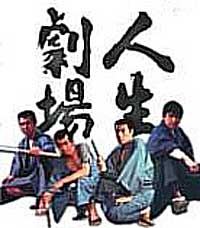 Based on Koyo Ozaki's novel Theater of Life (Jinsei Gekijo), Tomu Uchida directed with an all-star cast Hisakaku & Kiratsune: A Tale of Two Yakuza (Jinsei Gekijo: Hishaku to Kiratsune, Toei, 1968). Based on Koyo Ozaki's novel Theater of Life (Jinsei Gekijo), Tomu Uchida directed with an all-star cast Hisakaku & Kiratsune: A Tale of Two Yakuza (Jinsei Gekijo: Hishaku to Kiratsune, Toei, 1968).
Uchida had earlier filmed the story as Jinsei gekijo: Seishun hen (Theater of Life: Youth Version, Nikkatsu, 1936). The rise of the yakuza film as a distinct genre was still in the future, & this adaptation of Ozaki focused less on gangsterism & more on the hero's childhood & youth at the close of the Meiji era.
In this satiric but decidely tragic look at the misguided values of mercantilism, a man rejects his childhood sweetheart & marries for gain, with a long-term plan of becoming a politician with all the money & power politics can gain for a successful man.
In her heartbreak, his abandoned sweetheart enters the world of geishas. She rises in national popularity as one of the most beautiful women of her era. The man who pursued success found none, & remained in obscurity.
A remake of the "youth version" (Jinsei gekijo: Seishun hen, 1958) was directed by Toshio Sugie. It has an amazing cast leading off with Ryo Ikebe, but the film is long out of circulation. Toshio Masuda filmed it again (Jinsei gekijo, 1964), starring Hideki Takahashi.
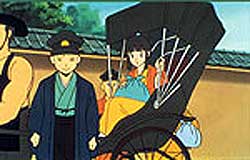 There's also a "cleaned up" animated half-hour version made for television in 1986, which reverts to "the youth version" of the epic novel's early chapters so as not to upraise gangsterism. This little animated version is available subtitled in the "Animated Classics of Japanese Literature" series. There's also a "cleaned up" animated half-hour version made for television in 1986, which reverts to "the youth version" of the epic novel's early chapters so as not to upraise gangsterism. This little animated version is available subtitled in the "Animated Classics of Japanese Literature" series.
These versions rather than yakuza films are part of the genre called Meiji-mono, about weak men who fail to make it through the changes of the Meiji Restoration with their own masculine authority intact. The "weak hero" of Meiji-mono films are invariably involved with strong & loving women who are more apt to be able to keep families, or the nation, from falling apart.
By the 1960s the novel's material on gangsterism became the preferred focus. It was remade by Tai Kato as a well-budgeted three-hour version as Theater of Life; aka, Stage of Life (Jinsei gekijo: Seishun aiyoku zankyohen, Shochiku, 1973).
Kato's film is lavishly filmed, but the stars in Uchida's version make it more pleasing despite its comparative budget restrictions in 1968.
It went through several other versions, the last having been an anthology of vignettes from three directors released in 1983, with Kinji Fukasaku leading off three yakuza directors.
So Ozaki's Theater of Life contributed enormously & formatively to the filmic "literature" of chivalrous gamblers, in remake after remake.
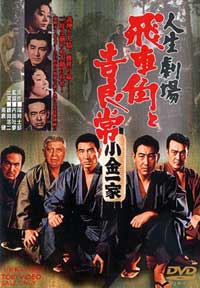 The formidable significance of Tomu Uchida as director, as well as his fantastic cast, renders Uchida's version the default standard. Hishakaku, or just Kaku, played by Koji Tsuruta, is a chivalrous gambler in a world of decidedly unchivalrous gangsters. He lives by a code which others ignore. The formidable significance of Tomu Uchida as director, as well as his fantastic cast, renders Uchida's version the default standard. Hishakaku, or just Kaku, played by Koji Tsuruta, is a chivalrous gambler in a world of decidedly unchivalrous gangsters. He lives by a code which others ignore.
Part of that code assumes yakuza fulfill a very real human need for gambling & whoring, so that they provide these services for people who are actually seeking them, but must otherwise "walk in shadow" avoiding the sunlight & not bothering decent people. But an equally important part of the code is a gambler's absolute faithfulness to his oyabun, or godfather, & the gang with whom he is affiliated, even if the godfather is inhumane & corrupt.
The heart of ninkyo-eiga or yakuza chivalry-films is the torture just such a character feels between his duty or obligation to his oyabun & gang, & his personal sense of humanity.
Kaku eventually meets an older man who is more like himself than are any of his contemporaries: Kiratsune or Tsune, played by Ryutaro Tatsumi.
Miyagawa, a sort of updated yojimbo (samurai bodyguard), is a swordsman employed by the local gang boss. He's played as the third of the chivalrous characters trapped in criminal social order that has fewer & fewer opportunities for chivalry, but only for violence & angst.
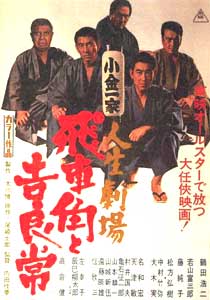 Such men tend to become disheartened with life & live in perpetual melancholy, because their deep sense of honor requires them to do two things that each contradicts the other: obey the oyabun, but do no harm to the meak. The actors who play these roles ideally have sad expressions, & the tragic visages of Ken Takakura & Koji Tsuruta express the far extreme of unhappy manly beauty. Such men tend to become disheartened with life & live in perpetual melancholy, because their deep sense of honor requires them to do two things that each contradicts the other: obey the oyabun, but do no harm to the meak. The actors who play these roles ideally have sad expressions, & the tragic visages of Ken Takakura & Koji Tsuruta express the far extreme of unhappy manly beauty.
In the homosocial worldview of such tales the most important relationship is always between two men. In many such stories the leading lady is all but a throw-away character who gets in the way of portraying the greater love between sworn brothers.
But Hisakaku & Kiratsune: A Tale of Two Yakuza follows a slightly different pattern, in that Kaku's beloved, Otoyo (played by Junko Fuji the chivalrous heroine of the Red Peony Gambler series), is of equal significance to the windings of the tale.
Kaku snared by his own obligation ends up stabbing one oyabun in service of another, & consequently serves four years in prison. During that time, Otoyo turns to Miyagawa for protection & ultimately affection.
They struggle against their feelings, as they love & respect Kaku. If they act on their feelings, they will be the worst imaginable betrayers & hate themselves always. If they ignore their feelings, they will live unfufilled lives. Their affair exactly parallels the chivalrous yakuza's pull between giri (duty) & ninkyo (humanity), or obligation & chivalry.
These anguished interpersonal relationships build against a backdrop of gang warfare & swordfights in Taisho Era settings. The climax of such films consist of all-out bloodbaths, & this is certainly the case with Hishakaku & Kiratsune, the baptismal in blood not only required by the usual sense of chivalry necessitating the death of evil men, lost friends avenged, & the meak effectively protected at great personal loss.
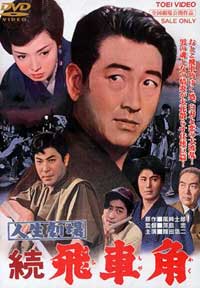 The story taken from one of the central masterpieces of chivalrous gambler fiction provided Tomu Uchida with spectacular material for a gravely beautiful film of emotionally extreme sentiment blended with violence. It's a wonderful film & deserves to be famous, but the same could be said of other versions of the same story. The story taken from one of the central masterpieces of chivalrous gambler fiction provided Tomu Uchida with spectacular material for a gravely beautiful film of emotionally extreme sentiment blended with violence. It's a wonderful film & deserves to be famous, but the same could be said of other versions of the same story.
Tomu Uchida's scriptwriter had already written a version of the story for director Tadashi Sawashima, done as a pair of films, Jinsei gekijo: Hishakaku (Toei, 1963) & Jinsei gekijo: Zoku Hishakaku (Toei, 1963) which had already starred Koji Tsuruta & Ken Takakura.
This pair was released early enough to unexpectedly large commercial success. They were to have a major impact on the idealized ninkyo-eiga that reached a peak of popularity in the mid-1960s. The first of these two films portrays Kaku (Tsuruta) as a quiet, decent fellow as gamblers go, in love with a courtesan Otoyo (Yoshiko Sakuma). As a wanderer, he convinces Otoyo to come away with him, though she has an indenture contract locally.
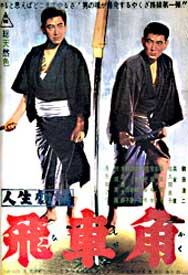 They come to Tokyo together where Kaku is protected by the oyabun Kokin (Yoshi Kato). Due to his obligation to Kokin, he becomes involved with a gang war, & ends up attacking Kokin's rival godfather, afterward hiding out with an "old style" yakuza, Kiratsune (Ryunosuke Tsukigata), a chivalrous gambler of the highest order of decency, but whose modes & methods are very outmoded in the new era. They come to Tokyo together where Kaku is protected by the oyabun Kokin (Yoshi Kato). Due to his obligation to Kokin, he becomes involved with a gang war, & ends up attacking Kokin's rival godfather, afterward hiding out with an "old style" yakuza, Kiratsune (Ryunosuke Tsukigata), a chivalrous gambler of the highest order of decency, but whose modes & methods are very outmoded in the new era.
The gang warfare element of the film is convoluted & effective enough, providing excuses for action. But it is the fate of Otoyo & Kaku as lovers that most matters, Kaku's "obligations" in the yakuza world keeping them apart not least because of his stint in prison. During this time, Otoyo struggles against sinister gangsters who see in her not the sweetheart of a chivalrous gambler doing time for his gang, but as a marketable commodity.
The swordsman Miyagawa (Ken Takakura) intercedes in Otoyo's behalf . The romance that develops between them causes anguish & sorrow for both, because Otoyo seriously intended to wait for Kaku to serve his time. By the time Kaku is out of prison three years later, everything has changed, & Otoyo & Miyagawa cause the worst heartache to a man neither ever intended to harm.
It means, though, that Kaku is not after all leaving someone behind if he goes on a raid against an increasingly unforgivable oyabun's headquarters, in the one-against-many climactic sword battle de rigour for ninkyo-eiga, ending not conclusively as there are many loose ends to follow up on in the immediate sequel.
Tadashi Sawashima would return to these characters a third time, later in the decade with New Adventures of Kakutaro (Shin Hishakaku, Toei, 1967). It's a sequel more or less to the 1963 epic film pair.
By 1967 the end was already in sight for the ninkyo-eiga craze, & the films had turned into overly standardized product that sort of deserved their fad to end. Returning to such famous characters was a desparate bid to regain audiences by increasing the familiarity quotient rather than the quality or the originality.
So Shin Hishakaku is a genre potboiler with excruciatingly bad editing rendering the flashbacks & flash-forwards difficult to sort out. Koji Tsuruta for the last time stars as Yoshii Kakutaro aka Hishakaku or Kaku.
Tsuruta is not playing his usual stoic dead-pan yakuza hero, but a whiner & a complainer who on a drunken spree with tears in his eyes declares, "I'm satisfied to be a fool, but I've a glittering spirit inside!"
The classical ninkyo hero would never have to brag about his glittering spirit; it would be evident by his gaze & by his actions. But the weakness of the character makes Kaku more human, & the film builds toward an ending which is high-tragedy for its love story.
The violence of the film is not as heartfelt as the love story, which is almost refreshing for a yakuza film, from a director unwilling to be too grossly violent. The one-against-all battle early in the story, body tattoo revealed for the only time, ends with the stabbing but not the killing of Kaku's rival (Kei Sato) -- in the nuts.
The scene exudes tackiness more than grotesquerie & is so devoid of conviction that the film fails as exploitation, without really being artful enough to succeed at anything more than exploitation.
Kei Sato's character vanishes from the film thereafter &, over all, the story seems to have been made up as it was filmed, with little or no relationship between the events of the first part of the film to those of the ending.
There's an attempt to convey a sense of desperation in the yakuza hero who, before the war, could boast of being a chivalrous man in the gang-world, but after the war discovers gangsterism to be empty of the kyokaku spirit.
The hero sees drugs & prostitution & a Japan degraded by the Occupation. A moment of beauty -- buying flowers from an innocent little girl -- turns to nightmare when her innocence proves a ploy & she propositions him.
When his oyabun is murdered & his degenerate gang broken up, he takes to the road, seeing poverty throughout Japan, searching forlornly for his wife.
Coming to a small town, he meets a direct descendant of the chivalrous outlaw Jirocho of Shimizu. This fellow is played by the great character actor Takashi Shimura (the lead in Seven Samurai). In him, Kaku discovers that chivalry after all does still exist, though it is elderly & painfully rare.
A group of desparate ex-soldiers have formed a cruel rival gang which Kaku eventually desimates in yet another unfelt battle which takes place in the black market warehouse.
The chief villain is a minor character seen so rarely we're not even certain of his villainy. Kaku finally reaches him & wrestles with him in a slick of spilled vegetable oil. It's all pretty silly & the director seems to know it.
We don't actually see Kaku kill the villain & the real climax is in the epilog. Kaku stumbles down a beach, badly wounded, barely missing his rendezvous with his long-lost wife (Yoshiko Sakuma), barely missing his final chance of happiness. Well boo hoo.
copyright © by Paghat the Ratgirl
|
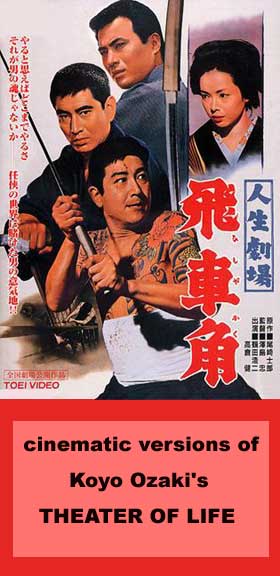

 There's also a "cleaned up" animated half-hour version made for television in 1986, which reverts to "the youth version" of the epic novel's early chapters so as not to upraise gangsterism. This little animated version is available subtitled in the "Animated Classics of Japanese Literature" series.
There's also a "cleaned up" animated half-hour version made for television in 1986, which reverts to "the youth version" of the epic novel's early chapters so as not to upraise gangsterism. This little animated version is available subtitled in the "Animated Classics of Japanese Literature" series.
 Such men tend to become disheartened with life & live in perpetual melancholy, because their deep sense of honor requires them to do two things that each contradicts the other: obey the oyabun, but do no harm to the meak. The actors who play these roles ideally have sad expressions, & the tragic visages of Ken Takakura & Koji Tsuruta express the far extreme of unhappy manly beauty.
Such men tend to become disheartened with life & live in perpetual melancholy, because their deep sense of honor requires them to do two things that each contradicts the other: obey the oyabun, but do no harm to the meak. The actors who play these roles ideally have sad expressions, & the tragic visages of Ken Takakura & Koji Tsuruta express the far extreme of unhappy manly beauty.
 They come to Tokyo together where Kaku is protected by the oyabun Kokin (Yoshi Kato). Due to his obligation to Kokin, he becomes involved with a gang war, & ends up attacking Kokin's rival godfather, afterward hiding out with an "old style" yakuza, Kiratsune (Ryunosuke Tsukigata), a chivalrous gambler of the highest order of decency, but whose modes & methods are very outmoded in the new era.
They come to Tokyo together where Kaku is protected by the oyabun Kokin (Yoshi Kato). Due to his obligation to Kokin, he becomes involved with a gang war, & ends up attacking Kokin's rival godfather, afterward hiding out with an "old style" yakuza, Kiratsune (Ryunosuke Tsukigata), a chivalrous gambler of the highest order of decency, but whose modes & methods are very outmoded in the new era.